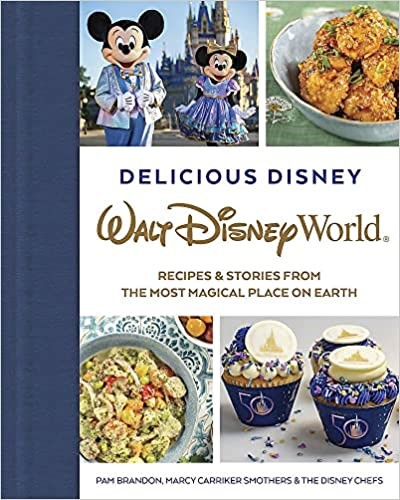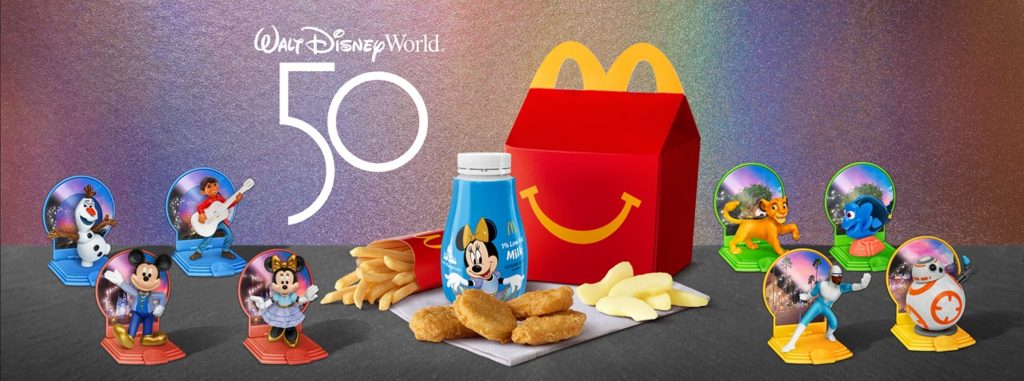Category — A Friday Visit with Jim Korkis
Fridays with Jim Korkis: Bongos Cuban Cafe
Welcome back to Fridays with Jim Korkis! Jim, the dean of Disney historians, writes about Walt Disney World history every Friday on yourfirstvisit.net.
BONGOS CUBAN CAFE
By Jim Korkis
Bongos Cuban Café with both indoor and outdoor seating for up to 550 guests opened at Downtown Disney’s West Side in September 1997 and closed in August 2019. During its twenty-two years of operation, it remained pretty much the same without any significant changes. It was the only original restaurant at West Side that had never renovated in any manner.
International superstars Emilio and Gloria Estefan were the owners of Bongos Cuban Café that showcased a blend of authentic Cuban cuisine with the culture of old Havana, presented in a setting that mixed tropical deco with the sizzle of South Beach glamour.
In 1993, the couple entered the restaurant business with two successful restaurants on Miami’s famous Ocean Drive: Larios and Allioli. At the opening of the Bongos location, Emilio Estefan said, “Gloria and I are pleased to bring the Cuban tradition and heritage to Disney World, where so many people from around the world will be able to enjoy it.”
The building’s triangular architectural design, by the renowned architect Bernardo Fort Brescia, was dominated by the massive seventy-five foot tall pineapple-shaped adobe structure. The pineapple leaves alone weighed 37,500 pounds.
Guests were able to walk into the pineapple (a traditional symbol of hospitality), visit the Pineapple bar in the center of the room, and eat in one of the seven, small individual coves that lined the outer rim of the giant structure.
The tables featured lighting illuminating the table from within. The second floor balcony also offered seating and a second bar.
Well-known interior designer Luciano Franchi supplied distinctive touches from a dazzling mosaic of hand-painted murals evoking old world Cuba of the 1940s and 1950s to conga drum-shaped bar stools.
The images of Cuba were made up of tiny glass mosaic tiles. Huge sculptures of palm trees with leaves that spread across the ceiling filled the restaurant. The ceiling coves featured fiber optic lighting that allowed them to change color.
In addition, there was a stage for nightly entertainment and the restaurant was known for its lively Latin rhythms and dancing.
The restaurant featured authentic Cuban cuisine including tostones rellenos, con camarones, enchilados o picadillio, pan con lechon and paella de mariscos. At the time of its opening, it was the only place in the world to feature Hatuey draft beer on tap.
An express window at the front offered Cuban sandwiches, pastries, soft drinks and Cuban specialty drinks. A shop inside the restaurant offered merchandise including t-shirts, sweatshirts, chocolate Cuban cigars and other items personally chosen by the Estefans.
“With the lease coming to full term this summer (2019), rather than renovating the current location, we’re transitioning our brand into Estefan Kitchen at Margaritaville Resort Orlando,” Estefan’s team said in a statement with many of the restaurant workers moving to the new location.
“They (Disney Springs) are growing in a different direction, and we are growing in a different direction. So we thought a fresh start is wanted,” said Gloria Estefan.
The site was demolished, and construction on a new restaurant was reportedly postponed because of COVID restrictions effecting building. It is now just a green space. It was supposed to be the site of a Beatrix healthy food location, but that was eventually cancelled.
It was later announced that the site would be Summer House on the Lake to open in 2023. The new location is a spin-off of the popular Chicago and North Bethesda, Maryland restaurant Summer House Santa Monica owned by the same company that owns Beatrix.
* * * * *
Thanks, Jim! And come back next Friday for more from Jim Korkis!
In the meantime, check out his books, including his latest, Off to Never Land: 70 Years of Disney’s Peter Pan and Final Secret Stories of Walt Disney World!
Follow yourfirstvisit.net on Facebook or Twitter or Pinterest!!
October 10, 2022 No Comments
Fridays with Jim Korkis: Delicious Disney
Welcome back to Fridays with Jim Korkis! Jim, the dean of Disney historians, writes about Walt Disney World history every Friday on yourfirstvisit.net.
YOUR PERSONAL DISNEY LIBRARY (56)
By Jim Korkis
- Delicious Disney: Walt Disney World: Recipes & Stories from The Most Magical Place on Earth by Pam Brandon and Marcy Smothers
It has never been my intention to review travel books because there are just too many of them and they quickly go out of date, nor has it been my intention to review Disney cookbooks because cooking is definitely outside my area of expertise–I have never used a recipe in any cookbook!
However, there are always exceptions, especially if the book offers something out-of-the-ordinary like the Unofficial Disney Parks Cookbook I previously reviewed on this site. Delicious Disney falls into that same category because even if you ignore every single recipe in this book, there is still enough material of value if you are interested in Walt Disney World history to add this book to your collection.
The co-authors of Delicious Disney are Pam Brandon, who is well known in the Disney foodie community for authoring over twenty cookbooks officially approved by Disney, and Marcy Smothers, who authored Eat Like Walt and Walt’s Disneyland: A Walk in the Park with Walt Disney. Her credentials as a Disney historian who does original research and shares previously undocumented material are very solid.
It is the contribution of Smothers that makes this book interesting and valuable, with her adding historical background, selecting appropriate quotations, and also influencing the images that are included.
In fact, Delicious Disney starts with a rarely known quotation by Imagineer John Hench: “It was Walt’s idea that while dining was an experience, we should augment it in any way we could. After all, he was a showman.” That quote is accompanied by a black-and-white photo of Walt and Hench from 1965 experiencing the newly remodeled Plaza Inn on Disneyland’s Main Street.
Delicious Disney is nine chapters running 320 pages and its binding makes it difficult to use in a kitchen setting. Some have complained about which recipes were chosen to include and which were left out. For me, I felt there was a nice balance of recipes from yesteryear to some favorites of today and all of them covering the Walt Disney World parks and resorts.
I liked seeing the recipe of the Handwich, the “one-hand sandwich”, actually developed by Imagineering, that was hugely popular when it debuted at WDW in 1987. Of course, more familiar recipes are included as well like the Canadian Cheddar Cheese Soup from Epcot’s World Showcase, Tonga Toast from Disney’s Polynesian Village resort, and the Grapefruit Cake from Disney’s Hollywood Studios.
In addition, there are several recipes served today on WDW property that are plant based. Beverages have their own separate chapter, featuring Walt Disney’s Scotch Mist, the Kungaloosh from the sorely missed Adventurers Club, Orange Bird Flip, Huckleberry Punch, and more that I have not seen in other cookbooks.
Again, I was very excited to see not only a large clear photo of the dish itself that was being discussed but photos of the location (many of them being photos I hadn’t seen before) and wonderful examples of concept art for the restaurants and large, clear images of classic menus.
As always with Disney Editions books, the color photos are magnificent and I appreciated that some of those photos were close ups of details in the restaurant with the text focusing on the storytelling and theming of the locations.
I debated about purchasing this book but now that it is in my collection, I would certainly look forward to a sequel if it included similar material presented in a similar manner.
* * * * *
Thanks, Jim! And come back next Friday for more from Jim Korkis!
In the meantime, check out his books, including his latest, Off to Never Land: 70 Years of Disney’s Peter Pan and Final Secret Stories of Walt Disney World!
Follow yourfirstvisit.net on Facebook or Twitter or Pinterest!!
September 28, 2022 No Comments
Fridays with Jim Korkis: Sonny Eclipse
Welcome back to Fridays with Jim Korkis! Jim, the dean of Disney historians, writes about Walt Disney World history every Friday on yourfirstvisit.net.
SONNY ECLIPSE IN COSMIC RAY’S STARLIGHT CAFE
By Jim Korkis
I’ve written about Sonny Eclipse before in an earlier column but I never explained how close the entertainer at Cosmic Ray’s came to never existing at all.
Sonny is definitely the archetypal lounge singer, with his sequined suit, gaudy gold rings and shock of red hair, sitting behind his Astro Organ and telling some of the worst jokes in the universe (“You know I heard the universe is expanding. Guess it’s time to loosen the old asteroid belt!”)
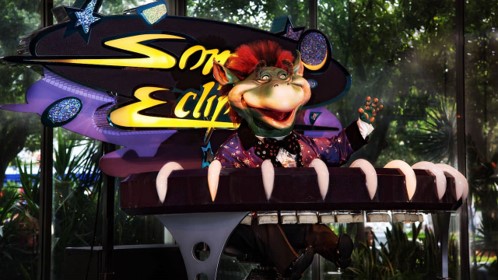
(c) Disney
Backed by a trio of invisible singing hopefuls known as the Space Angels, the green-skinned, unearthly Sonny Eclipse made his debut in the summer of 1995 at Cosmic Ray’s Starlight Café in Walt Disney World’s Tomorrowland.
He never would have appeared except for the persistence and cleverness of Imagineering Show Producer Paul Osterhout and Senior Concept writer Kevin Rafferty.
Cosmic Ray’s was already a highly popular food and beverage location at the park, and did not need any enhancements to draw a larger crowd. In addition, Sonny was not considered a “big ticket attraction” that would boost attendance. It is simply one of the many “hidden treasures” at the Magic Kingdom that receive no advertisement but are discovered accidentally by guests.
Rafferty said, “It’s just this nice little surprise from outer space.”
Sonny was included in the original plans to revamp Tomorrowland, but was soon canceled due to budgetary constraints. However, Osterhout kept a close eye on the expenses for the new Tomorrowland, and when it started to come in under budget he got the green light for Sonny from Senior Vice President of WDI Creative Development Eric Jacobsen. Jacobsen jokingly told Rafferty, “Okay, you can do your stupid show.”
The show was originally meant to feature an audio-animatronics character like Alec-Tronic at Innoventions but when they saw that the new Tomorrowland already included Timekeeper, the Robo-Newz vendor and the demonstration droid in ExtraTERRORestial Alien Encounter, it was decided that the robot population was already too large.
So Osterhout and Rafferty came up with an alien lounge singer for a food and beverage location.
“He’s low key so people can watch him or just eat their food,” said Rafferty. “There are terrible jokes but the humor probably isn’t bad enough to make guests lose their appetites, but it was not for lack of trying.”
During script development, Osterhout presented writer Rafferty with two pages of the worst lounge jokes he ever heard gathered from his previous career as a traveling magician in Florida. The final twenty-seven minute show only contains two of those jokes.
“The show would be two hours long if we used all of Paul’s jokes,” said Rafferty.
“And we definitely wouldn’t want those jokes to repeat on the next loop,” said Osterhout.
Rafferty wrote the final script and jokes and stated, “Before Sonny came to Earth, he was working in a lunar lounge on the moon but he didn’t like it because it had no atmosphere.”
Sonny Eclipse’s set list consists of eight songs, written by George Wilkins and Kevin Rafferty. These songs include:
- “My Name is Sonny Eclipse”, his personal theme song
- “Out in Space”, a ballad about the Earth’s beauty
- “Hello Space Angels”
- “Gravity Blues”
- “Starlight Soup and Salad”, about the restaurant’s menu
- “Bright Little Star”, a love song
- “Planetary Boogie”
- “Yew Nork, Yew Nork”
* * * * *
Thanks, Jim! And come back next Friday for more from Jim Korkis!
In the meantime, check out his books, including his latest, Off to Never Land: 70 Years of Disney’s Peter Pan and Final Secret Stories of Walt Disney World!
Follow yourfirstvisit.net on Facebook or Twitter or Pinterest!!
September 23, 2022 No Comments
Fridays with Jim Korkis: McDonalds in Downtown Disney
Welcome back to Fridays with Jim Korkis! Jim, the dean of Disney historians, writes about Walt Disney World history every Friday on yourfirstvisit.net.
MCDONALDS AT WALT DISNEY WORLD
By Jim Korkis
Things are constantly changing on Walt Disney World property. The McDonalds restaurant near the All Star Resorts at the intersection of Osceola Parkway and West Buena Vista Drive was closed last October and reopened in May of this year with solar panel awnings offering guests some shade as well as collecting some energy to help fuel the restaurant.
This restaurant is now larger. Inside are markers on the floor with fun facts about solar energy. Stationary bicycles off to the outside of the restaurant, if pedaled fast enough, will light up the Mickey D sign.
However, this is actually the location of the second full McDonalds on Walt Disney World property. The first was at the former Downtown Disney (now Disney Springs) between the Lego Store and the T-Rex restaurant, called Ronald’s Fun House.
In December 1997 it opened as part of the ten year arrangement with Disney that included fries being served at Fairfax Fries at Disney’s Hollywood Studios; fries, chicken McNuggets and McFlurrys at the Refreshment Port in World Showcase in Epcot; the Frontierland Fries Wagon at the Magic Kingdom, and Restaurantosaurus at Disney’s Animal Kingdom that offered an enhanced McDonalds’ menu that included hot dogs, mandarin chicken salad and more, in addition to the usual McDonalds’ offerings.
The Orlando Sentinel reported on the Disney Springs venue in September 1997 that “Ronald’s Fun House features specially designed rooms and decor inspired by Ronald McDonald and other McDonaldland characters. Ronald’s Fun House will feature “Ronald’s Dining Room,” with a formal 20-foot serpentine dining table, “Birdie’s Music Room,” featuring a giant French fry organ, and “Grimace’s Game Room,” with an interactive video/game wall. Located on the east side of Downtown Disney, the new restaurant will be open for business 365 days a year.
“We are excited about the opportunity to bring the food, folks and fun of McDonald’s to guests at Walt Disney World Resort’, said Brad Ball, McDonald’s senior vice president, U.S. marketing.”
Guest entered the Hamburglar’s Kitchen through a golden archway. Inspired by the prankster in the McDonald’s franchise, the area had a lobby highlighted by a black-and-white striped floor to match his clothes, with red tiles shaped like the Hamburglar’s tie. A larger-than-life Happy Meal train moved on an overhead track while guests ordered their food.
There were three interior dining rooms and an outside patio. Ronald’s Dining Room included a twenty foot long serpentine table that sat twenty-two people. It also included a space to purchase branded gift items and apparel.
Birdie’s Music Room was designed to look like the inside of a bird house. The room contained a French fry organ created to look like a McDonald’s red French fry box.
Grimace’s Game Room was decorated in the character’s signature purple color. An interactive game wall entertained children as they and their parents dined.
Brad Ball stated, “This new restaurant is a good example of the way our two brands can team up to provide unique experiences for families that only McDonald’s and Disney can deliver.”
Within five years it was among the top five McDonald’s restaurants in the United States and in the top one percent in the world in sales volume.
In addition to providing a 10,107 square foot restaurant to guests, this McDonald’s also featured a separate indoor 2,000 square foot area adjacent to the guest section with seating for a hundred Disney cast members. It was open twenty-four hours a day exclusively for cast with McDonald’s food served from eight am to three am. It also included vending machines.
This McDonald’s closed on April 30, 2010, and was walled off as parts of the exterior McDonald’s decor were removed. The restaurant was converted into Pollo Campero, a Latin quick-serve Chicken restaurant, in November 2010. On March 19, 2014, Pollo Campero closed. The entire building was demolished by the end of the month.
* * * * *
Thanks, Jim! And come back next Friday for more from Jim Korkis!
In the meantime, check out his books, including his latest, Off to Never Land: 70 Years of Disney’s Peter Pan and Final Secret Stories of Walt Disney World!
Follow yourfirstvisit.net on Facebook or Twitter or Pinterest!!
September 19, 2022 No Comments
Fridays with Jim Korkis: America on Parade
Welcome back to Fridays with Jim Korkis! Jim, the dean of Disney historians, writes about Walt Disney World history every Friday on yourfirstvisit.net.
AMERICA ON PARADE
By Jim Korkis
In 1976, the country gathered to celebrate its Bicentennial, the 200th anniversary of the Declaration of Independence. Development for the Disney theme parks celebration began in 1972 under the guidance of entertainment executive Bob Jani.
As part of that celebration there was one of the most spectacular parades ever at Walt Disney World: America on Parade. The Walt Disney World version of the patriotic parade debuted on June 6th, 1975, a week before its Disneyland counterpart. It was seen by an estimated twenty-five million people at the parks before its final performance in September 1976.
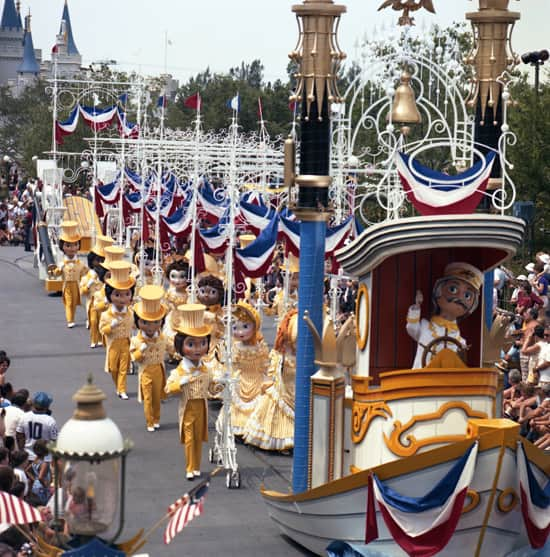
(c) Disney
Disney’s America on Parade concentrated on the ideals, principles and important figures that shaped the nation. It showcased memorable moments like the first Thanksgiving, significant American innovations like the invention of the car and the first manned flight, popular pastimes like baseball, and more.
A hundred and fifty eight-foot tall human figures were built to represent the “people of America.”. The fifty parade units were designed to look like huge toys, and the figures to be outsized dolls with the theme being seeing America through the eyes of a child.
Proclaimed as a “new achievement in Disney pageantry,” this colorful tribute to the history and legacy of the United States was one of the most celebrated presentations in Disney theme park history. Intended to convey the festive feel of the Fourth of July, it was a spectacular homage to America’s history, people, and traditions characterized by Disney as a “birthday party for the country.”
“In the Spirit of ‘76, Walt Disney Productions proudly presents America on Parade – a salute to America’s 200th birthday! Two centuries filled with challenges, achievements, and world contributions. Let’s step back into history and take a look at the first 200 years with this musical celebration.”
America on Parade was captured as a souvenir film sold through Walt Disney World’s Magic Kingdom and Disneyland. The “Walt Disney’s America on Parade” television special was aired in 1976, hosted by Red Skelton, and featuring a number of performances by the Kids of the Kingdom.
America on Parade was held once a day during winter months and twice a day during the summer season, with the night version concluding with the fireworks display. The parade was three-quarters of a mile long, which meant as the souvenir program put it, “a continuously moving ‘stage’ that captures the spirit of Americana in a grand display of colorful people and settings.”
Disney wanted a special musical instrument to provide a unique and memorable soundtrack for the parade and instituted a nationwide search for it. It turned out to be an 1890 band organ belonging to Paul Eakin and named “Sadie Mae of St. Louis.”
Jani had wanted to try to mix old-world sounds with new, and came up with the idea of combining an antique band organ with synthesizer to achieve this result. There was only one man in the world, in Belgium, who could still make punch cards for 1890 band organ and its over 200 different pipes.
The parade was hugely popular and a flood of related merchandise was released including collectable coins, mugs, picture and history books, a series of plates, View-Master reels, puzzles, watches, coloring and sticker books, Colorforms play sets, a figural music box, a porcelain sculpture and a lunch box-and-thermos kit. The full score was available in its entirety at both parks on a distinctive limited edition picture disc, A Musical Souvenir of America on Parade.
* * * * *
Thanks, Jim! And come back next Friday for more from Jim Korkis!
In the meantime, check out his books, including his latest, Off to Never Land: 70 Years of Disney’s Peter Pan and Final Secret Stories of Walt Disney World!
Follow yourfirstvisit.net on Facebook or Twitter or Pinterest!!
September 13, 2022 No Comments
Fridays with Jim Korkis: The West Side of Disney Springs
Welcome back to Fridays with Jim Korkis! Jim, the dean of Disney historians, writes about Walt Disney World history every Friday on yourfirstvisit.net.
THE WEST SIDE OF DISNEY SPRINGS
By Jim Korkis
Disney Springs is the outdoor shopping, dining and entertainment complex at Walt Disney World. It gained this name in 2015, and today most fans know the area by that name. The complex has always been meant to both keep guests on Walt Disney World property and also to generate revenue from local residents.
It began as the Lake Buena Vista Shopping Village in 1975 and continued to evolve with an expansion in 1997 that included Pleasure Island and the then new West Side area. That area of nightclubs, theaters, themed restaurants and shops added an additional 66 acres to the original complex and was renamed Downtown Disney.
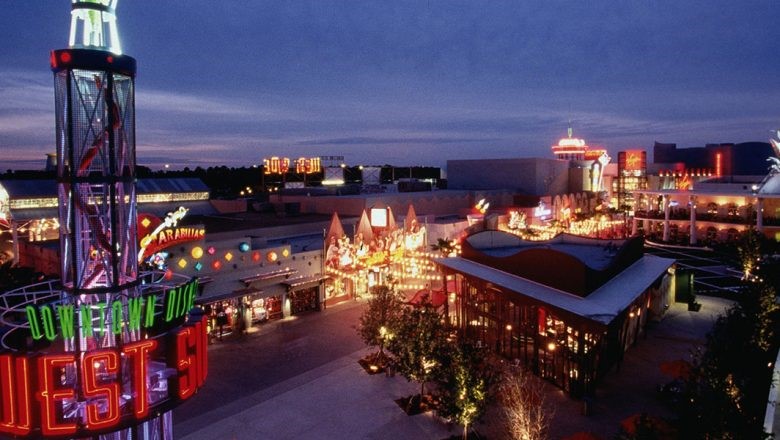
(c) Disney
According to the Imagineers the Downtown Disney name took “its inspiration from Broadway and Hollywood from traditional ‘downtowns’ coast-to-coast where America discovers the best of everything.”
In particular the new West Side offered some new opportunities for outside vendors. Imagineering felt it was a challenge to “integrate the design of the entire area so each venue could express itself and remain consistent in overall theming.”
Imagineering divided the area into “big”, “excitement” and “intimate”. “Big” referred to the huge buildings that ranged in size from 15,000 to 110,000 square feet. “Excitement” was supposedly the midway made up of pedestrian streets and plazas that stretched from one end of the West Side to the other. “Intimate” was the Esplande, a path along the lake that guests could stroll, and also the outside dining offered by Wolfgang Puck Cafe, Bongos Cuban Café and House of Blues.
Ralph Ireland, Wal Disney Imagineering (WDI) West Side assistant development manager of facilities development, stated at the opening, “WDI wanted the buildings to be constructed and arranged so that guests would naturally flow from one building to the next and be drawn to the Central Square, one of the focal points of the West Side.”
That Central Square included entrances to the AMC 24 Theaters, Virgin Megastore, Wolfgang Puck Café and Bongos Cuban Café.
WDI was in charge of the overall design of the West Side and met with the owners of the individual venues to make sure the companies followed Disney standards of design and construction. For example, WDI wanted restaurants that were along the lake to have two stories and outside dining available.
WDI designed the shell of all the West Side buildings so they would fit together and none would command more attention than any other, so each was limited to one icon that would set it apart from the other locations. For instance, Bongos Cuban Café had the 75 foot high pineapple (a traditional symbol of hospitality); Virgin Megastore had a hydraulic stage for outdoor performances and House of Blues had a water tower.
WDI also built the Front Street Connection, a bridge that brought guest underneath the existing bridge that spanned from the AMC Theaters to Pleasure Island. Using the Front Street Connection, guests were able to walk from the West Side to the Marketplace without entering Pleasure Island.
WDI also designed an information tower at the north end of the West Side to feature billboards displaying each venue’s logo and telephones that would connect guests directly to a venue.
West Side offered some different shopping experiences including “Magnetron Magnetz where every few minutes the lights will dim as the store’s magnetic generator is powered up. Guests will feel the energy as 20,000 magnets come to life that play music, ring, beep, light up, change color or glow in the dark” and “Celebrity Eyeworks resembling a mini-movie set featuring designer sunglasses and other eyewear including some replicas of glasses worn by celebrities in recent films.”
* * * * *
Thanks, Jim! And come back next Friday for more from Jim Korkis!
In the meantime, check out his books, including his latest, Off to Never Land: 70 Years of Disney’s Peter Pan and Final Secret Stories of Walt Disney World!
Follow yourfirstvisit.net on Facebook or Twitter or Pinterest!!
September 2, 2022 No Comments

